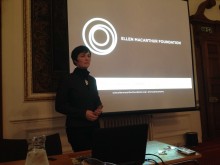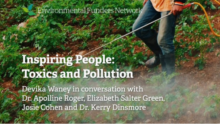Accelerating the transition to a circular economy
Notes from Dame Ellen MacArthur’s keynote speech to EFN members, 4 February 2015
 Dame Ellen began her talk with her story of becoming passionate about sailing from a young age and rapidly becoming a world-class sailor. In the middle of racing around the world solo, she found herself 2,000 km from the nearest shop and realised that her boat — the structure and contents of which she was relying on entirely to survive — was a microcosm of the world at large. The planet has finite resources, just as a sailboat does. She eventually decided to retire from sailing in order to focus on promoting the concept and reality of a circular economy.
Dame Ellen began her talk with her story of becoming passionate about sailing from a young age and rapidly becoming a world-class sailor. In the middle of racing around the world solo, she found herself 2,000 km from the nearest shop and realised that her boat — the structure and contents of which she was relying on entirely to survive — was a microcosm of the world at large. The planet has finite resources, just as a sailboat does. She eventually decided to retire from sailing in order to focus on promoting the concept and reality of a circular economy.
Following are notes from the rest of Dame Ellen’s talk:
The speed with which we have used each of the finite resources on which we rely has increased exponentially. Resource prices declined steadily until 2002, when basic commodities started (quite steeply) to become more expensive. Our economy has been incredibly linear – like a conveyor belt. Knowing we have finite resources, the strategy was all about doing less, using less. But we get motivated by positive things, things we want to run towards. If your goal is to use 10 percent less energy and materials every year, after X years you’re making nothing with nothing.
A Dutch carpet manufacturer decided that he’d rather lease carpet tiles than sell them; he would create them in a way to get the raw materials back and then turn them back into carpet. He also wanted to use entirely renewable energy at the factory by 2025.
What if the car industry, the construction industry, the plastic packaging industry were all the same, so that materials always have value and everything is designed so that nothing becomes wasted? What about food waste? Timber waste? Human waste? Agricultural waste? For billions of years that has gone back to the land, but we’ve broken that cycle. What would it look like if food waste went back to grow more food? What if the economy was more circular than linear?
The key question is: How do you build an economy in which everything is kept at its highest value at all times?
When the Ellen MacArthur Foundation was founded in 2010, they talked to their corporate partners – Cisco, Kingfisher, Philips, Renault, Unilever – and asked what this would look like for their businesses. They got £6 million in corporate funding just from those early conversations and that little understanding.
In order to shift to a circular economy, they decided they needed to focus on:
• Education (young people need to see the economy differently)
• Business (if businesses really do adopt this, it’s a way to really upscale it, to fast-forward it)
• Analysis and insight: They needed to understand the model in more depth
Six months in they went to see McKinsey asked three questions:
1) Does the circular economy have the ability to decouple growth from resource use?
2) Is it good for business?
3) Is it good for the broader economy?
McKinsey came back with answers:
Answer to 1): Yes. It would buy time for resource use.
Answer to 2): Yes. Look at washing machines: they are designed to work for a few year and then they mostly go to landfill. Some will be recycled, but not designed for anything else. Per wash it will cost 27¢ per wash. A high end machine costs 12¢ per wash. But no one wants to pay that upfront cost. Within the circular economy, people will have access to better machines with lower costs per wash. Businesses have incentive to build a much better washing machine and they make more money because not they’re not tied to buying new materials. It’s good for businesses and users.
Answer to 3): Absolutely yes. The addition of circular setups in the subset of EU manufacturing sectors could yield net material cost savings of up to $630 million p.a. All human, food, agricultural and household food waste combined could replace artificial fertilizer by 2.7 times — if we can systemically change the way our economy functions.
Topline figure from the report – a shift to a circular economy would release $706 billion per year net.
The Ellen MacArthurt Foundation launched their first report at the World Economic Forum — they weren’t invited, they just showed up in Davos and organised a small meeting with 30 people and launched their findings. A couple of people from the World Economic Forum came. One year later, they launched their second report and were invited into the World Economic Forum. The third year, they launched their report in conjunction with the World Economic Forum. That’s been a real lever for them.
Philips is already shifting to more circular models. They’re remanufacturing health equipment that they lease out to hospitals as a service, rather than selling. This changes the materials they use, reduces the materials they use, reduces their emissions (75% less material and 75% less energy when they leave the factory on average).
Cities and regions are turning to the foundation because they think this will bring employment. They’re also connecting to pioneer universities, including Imperial, Cranfield, Yale, MIT, UC Berkeley, Stanford, National Institute of Design in India, Tongji University in China, Delft University of Technology (Holland), Kedge Business School (France), MIP Politecnico de Milano. The Schmidt-MacArthur fellowship supports research into the circular economy at those places. Six of the univerisities have courses on the circular economy.
The Foundation held a Disruptive Innovation festival (Thinkdif.co) over four weeks last autumn. 100,000 people participated from 174 countries. There is so much appetite for a new model. The next festival will take place in November 2015.
The Foundation has also been collaborating with the MAVA Foundation on policy toolkit development. If you do x, y, z (levers), what will actually happen within your economy? They are running Denmark’s figures through that study to figure it out. There’s a real need to understand policy and what levers will help to accelerate circular activity.
Project Mainstream: collaboration between World Economic Forum and Ellen MacArthur Foundation with analysis from McKinsey looking at biggest challenges within our global economy. What are the stalemates that need a great number of people around the table to unblock – goverments, NGOs, companies, etc.?
The first project is global plastics and packaging. What would an economy look like if it was designed so that plastic never became waste but re-entered the economy as defined, valuable, biological or technical nutrients? So they don’t end up in oceans, so there’s more employment in the developing world. To resolve the issue, you need the biggest players who manufacture and design plastics. The convening power of the World Economic Forum proved quite extraordinary. Three of the biggest FMCG companies are participating in the group focusing on this. It’s the biggest project the Ellen MacArthur Foundation has put together to date. Because it’s so systemic and so early-stage, it’s the most challenging to fund. It’s not sexy, it’s going back to the beginning and saying, “How do we stop this from happening in the first place.”
Examples of circular economy in action
Michelin leasing out tyres – you pay per mile
Renault electric cars – you lease the battery; it goes back to them
Philips: Pay per lux. You don’t buy the lighting, you pay to have 450 lumens at desk height. Philips covers costs of the lighting and the expense of the electricity. The incentive is for them to have lowest-energy-use lighting. They replace when necessary.
Mazuma Mobile.com: They pay you for your old mobile phone. The faster it gets back into the economy the more value it has. They’ve already paid out £200 million for old phones. They’ve created a flow of old phones back to a base. That’s prompted a new form of leasing out phones where you give it back and get the newest one when it’s available. Then mobile phone operators develop relationships with manufacturers and the conversation about how can we get the most out of this phone possible happens.
Splosh provide household cleaning fluids. They send you a box with a certain number of slugs – highly concentrated cleaning product that you stick in a container and mix with water and the skin around the slug dissolves. Totally biodegradable. Bottles 100% recyclable and when you need new cleaning material, it comes through the post in a biodegradable box of slugs.
In all these cases, the incentive is for the product to last as long as possible before it is taken back for remanufacturing.
Feedback the Ellen MacArthur Foundation has received from businesses: if the playing field is flat, everyone will want to play on it.
